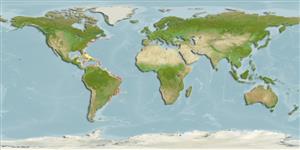>
Gadiformes (Cods) >
Macrouridae (Grenadiers or rattails)
Etymology: Malacocephalus: Greek, malakos = soft + Greek, kephale = head (Ref. 45335); okamurai: Named for Osamu Okamura.
Eponymy: Dr Osamu Okamura was Professor Emeritus at the Laboratory of Natural Science, Kochi University, where he was Professor of Zoology (1989). [...] (Ref. 128868), visit book page.
More on authors: Iwamoto & Arai.
Environment: milieu / climate zone / depth range / distribution range
Ökologie
seewasser bathydemersal; tiefenbereich 229 - 411 m (Ref. 33794). Deep-water
Western Central Atlantic: northeastern coast of South America off French Guiana and Brazil.
Size / Gewicht / Alter
Maturity: Lm ? range ? - ? cm
Max length : 28.0 cm TL Männchen/unbestimmt; (Ref. 33794)
Life cycle and mating behavior
Geschlechtsreife | Fortpflanzung | Ablaichen | Eier | Fecundity | Larven
Iwamoto, T. and T. Arai, 1987. A new grenadier Malacocephalus okamurai (Pisces: Gadiformes: Macrouridae) from the Western Atlantic. Copeia 1987(1):204-208. (Ref. 33794)
IUCN Rote Liste Status (Ref. 130435: Version 2024-1)
Bedrohung für Menschen
Harmless
Nutzung durch Menschen
Tools
Zusatzinformationen
Download XML
Internet Quellen
Estimates based on models
Preferred temperature (Ref.
123201): 10 - 16.4, mean 13.4 °C (based on 41 cells).
Phylogenetic diversity index (Ref.
82804): PD
50 = 0.5078 [Uniqueness, from 0.5 = low to 2.0 = high].
Bayesian length-weight: a=0.00102 (0.00046 - 0.00225), b=3.06 (2.88 - 3.24), in cm total length, based on all LWR estimates for this body shape (Ref.
93245).
Trophic level (Ref.
69278): 3.7 ±0.4 se; based on size and trophs of closest relatives
Widerstandsfähigkeit (Ref.
120179): mittel, Verdopplung der Population dauert 1,4 - 4,4 Jahre. (Preliminary K or Fecundity.).
Fishing Vulnerability (Ref.
59153): Low vulnerability (18 of 100).
